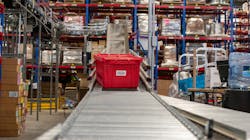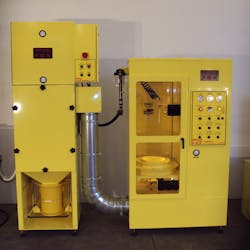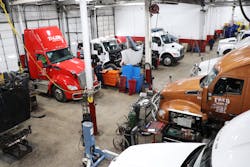This is Part One of a two-part story.
The last few years have been rough on the global supply chain, and there’s no telling when the scars left by the COVID-19 pandemic will fully heal. But for the transportation sector, it doesn’t really matter. Like a pack of great white sharks, if a fleet ceases movement, it risks death, or at least profitability. It’s sink or swim, and even when necessary repair and replacement parts were not available, fleets’ maintenance providers have to adapt or die.
This was all too common during the pandemic’s peak and can still be an impediment today. There might not be a global shortage of semiconductor chips, but certain specialty items, such as add-on systems, are “not readily available, causing some downtime, but not as broad a scale,” noted Rodney Gamble, GM and VP of parts sales and operations at FleetPride, an independent distributor of heavy-duty truck and trailer aftermarket parts.
Anything seems like an improvement over the parts issues in 2021, when diesel particulate filters were marked up 100% or more on eBay. These components are still difficult to come by.
“Of course, the aftertreatment system continues to be the biggest challenge,” Gamble said.
And it looks like the industry will have to collectively swim against the current for a while longer.
“I don’t think it’s completely eased; it’s just slightly better for all of us,” asserted Kent Jones, president of SAF-Holland (Americas), during the Heavy Duty Aftermarket Dialogue event in January. “At this point versus maybe a year ago, there are not 50 supply chain constraints causing problems, but there’s still five—and those five were different a month ago, and they change and evolve into the next five. So there still are shortages and, in many cases, they are still very significant. But they’re rotating and becoming a bit less.”
Because of the lingering issues, and the ever-present potential of some new disruption (wars, natural disasters, social unrest, alien invasion), everyone will have to learn quickly what has worked and what hasn’t as far as parts manufacturing and distribution during the pandemic, as well as how each link of the supply chain can make the others stronger. This will make the tough times easier to bear, and the easy times incredibly efficient and yes, more profitable.
Shop lessons learned: ‘Just keep trucking’
Because many of those deep cuts to the supply chain have taken longer to heal, a wider, more creative approach to parts procurement has become standard practice at plenty of shops.
The dealership, part of the Hissong Group, also has a 22-bay all-makes shop that’s always full of overflow from various fleets, such as the neighboring FedEx Freight terminal, as well as owner-operator business. The company runs six dealerships and three TRP Parts locations.
Fleet Maintenance visited the dealership in March to speak with the leadership team and the parts situation was top of mind. Management spoke specifically about their parts team’s resourcefulness and fleets’ willingness to compromise to get trucks back on the road.
When a radiator goes down and the warranty replacement would be eight months out, they would work to find an aftermarket replacement so the vehicle would generate revenue again. They also could turn to their FSX Equipment DPF cleaning machine as opposed to dealing with exploitative eBaymarkups.
Still, the Hissong team all concurred the supply chain interruptions remain one of—if not the most—critical issues.
“It has been very challenging,” professed Denise Vargo, service director at Hissong’s northern locations. “We still have parts issues these days.”
For example, Bob Wilson, VP of northern operations, explained that getting DEF quality sensors has caused “a year’s worth of problems,” before Vargo chimed in: “It still is.”
Currently, the big headache is right-hand stalk shifters for certain MY 2021-2022 transmissions.
“There’s really no idea, no end in sight,” Wilson said regarding the stalk shortage. “We don’t know what’s going on. It would be nice to have an idea of [the reason for] the shortage.”
Yet the dealership knows, like the rest of the industry, slowing down is not an option.
“We’re still waiting on parts, but the biggest thing is to just keep trucking,” Vargo offered.
One of the tricks is to be a good neighbor to nearby logistics companies that dot the west side of where Interstates 77 and 271 collide.
“We’ve definitely had times where we called [our contact] at FedEx Freight for some parts—and he’s definitely helped us out,” Wilson noted. “So, if we were short on something, we call him up.”
“Expand your personal network.” That’s a pro tip from the Kenworth dealer’s shop service manager Joel Turenne.
“The biggest thing is networking with everybody, because they may be the most important person you’ve ever called,” Turenne said. “Always keep their [phone] number. They may be your best friend next week. You just don’t know.”
Networking at events and trade shows has paid off through COVID-19 and now.
“We have repair facilities now that can fix some of these things that we’re having problems getting,” he said.
At Pitt Ohio, a carrier operating out of Pennsylvania and Ohio, sometimes turning to past strategies can also work.
“We went back to our old model from several years ago and started holding more parts in stock at our warehouse,” said Jason Dolence, Pitt Ohio’s manager of parts and warranty.
The fleet also buys up hard-to-source parts from vendor partners when they are in stock, he added. He noted cast parts and mirrors are still hard to come by.
“It has changed,” Dolence pointed out. “We not only lean on our local vendors that supply our warehouse operations, but we have been sourcing parts from vendors outside shop locals and moving them throughout the network.”
About the Author

John Hitch
Editor-in-chief, Fleet Maintenance
John Hitch is the award-winning editor-in-chief of Fleet Maintenance, where his mission is to provide maintenance leaders and technicians with the the latest information on tools, strategies, and best practices to keep their fleets' commercial vehicles moving.
He is based out of Cleveland, Ohio, and has worked in the B2B journalism space for more than a decade. Hitch was previously senior editor for FleetOwner and before that was technology editor for IndustryWeek and and managing editor of New Equipment Digest.
Hitch graduated from Kent State University and was editor of the student magazine The Burr in 2009.
The former sonar technician served honorably aboard the fast-attack submarine USS Oklahoma City (SSN-723), where he participated in counter-drug ops, an under-ice expedition, and other missions he's not allowed to talk about for several more decades.


